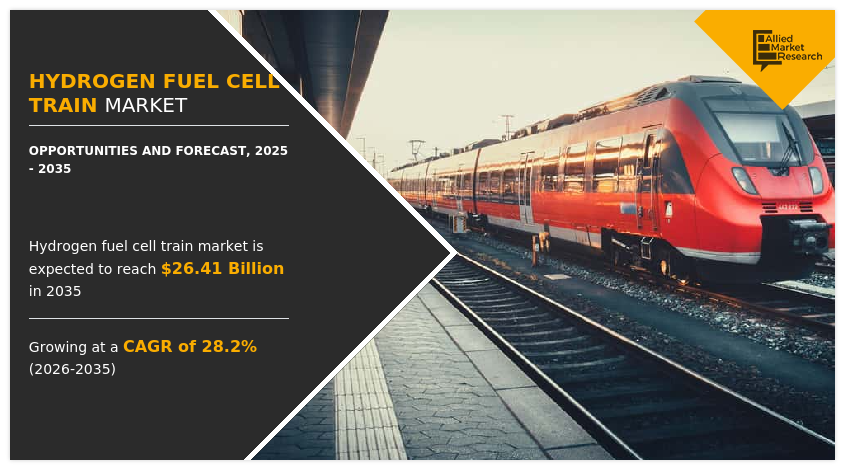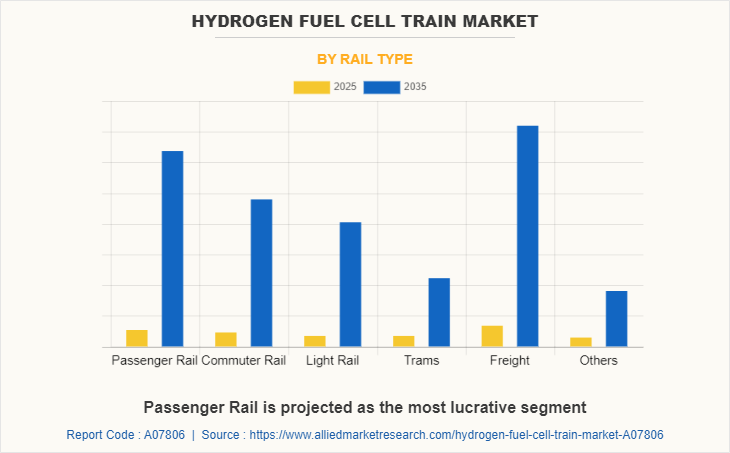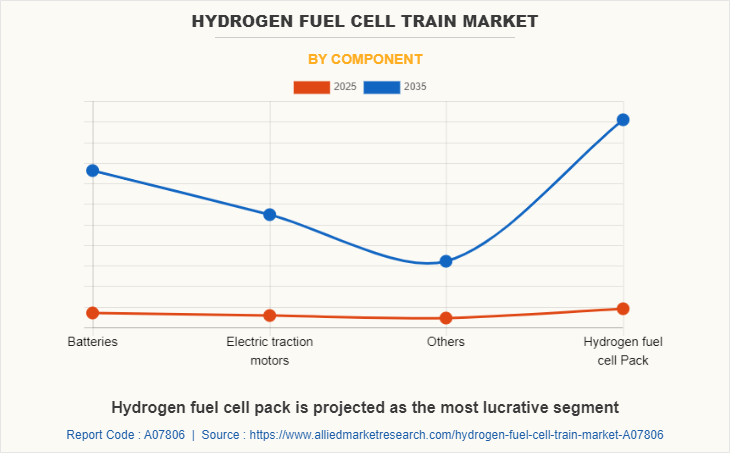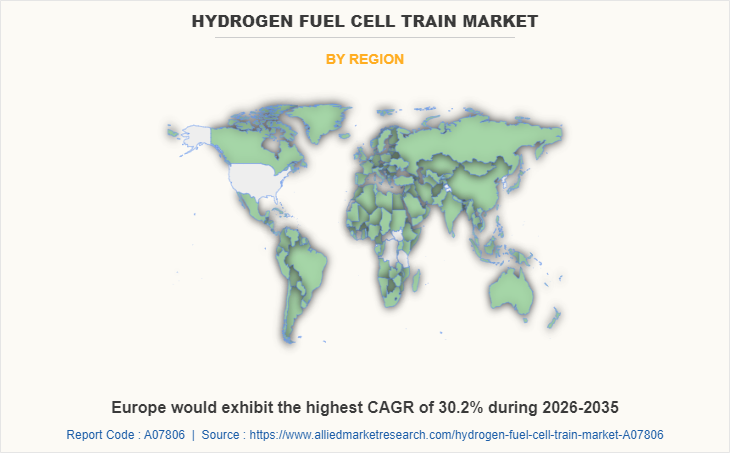The global hydrogen fuel cell train market size is expected to be valued at $2.67 billion in 2025, and is projected to reach $26.41 billion by 2035, growing at a CAGR of 28.2% from 2026 to 2035. Factors such as increase in investments in railway infrastructure development, increase in environmental concerns, and rise in demand for public transport services are anticipated to boost growth of the global hydrogen fuel cell train industry during the forecast period.

The hydrogen fuel cell train market is segmented into Application, Technology, Component and Rail type.
Hydrogen fuel cell train or hydrogen powered trains uses hydrogen as a power source for propulsion and auxiliary application. Research on hydrogen as a potential fuel to power zero-emission trains has been on the rise in recent years. The rail sector is working to develop technologies to tackle challenges associated with hydrogen storage infrastructure and public perceptions for safety and cost.
High capital requirement for development of hydrogen fuel cell trains and refurbishment of existing rolling stocks are expected to hinder growth of the global hydrogen fuel cell train industry during the forecast period. Moreover, increase in R&D activities related to hydrogen fuel cell technology and increase in demand for trains for passenger transportation are expected to create an opportunity for the hydrogen fuel cell train market during the forecast period.
The hydrogen fuel cell train market is segmented on the basis of application, technology, component, rail type, and region. By application, the market is divided into passenger train, freight train, and others. By technology, it is segmented into proton exchange membrane fuel cell, phosphoric acid fuel cell, and others. By component, it is divided into hydrogen fuel cell pack, batteries, electric traction motors, and others. By rail type, it is divided into passenger rail, commuter rail, light rail, trams, freight, and others. By region, the market is analyzed across North America, Europe, Asia-Pacific and LAMEA.

Competitive Analysiss
Key players that operate in this hydrogen fuel cell train market include Alstom, Ballard Power Systems., BNSF Railway Company, Construcciones Y Auxiliar De Ferrocarriles, S.A. (CAF), CRRC Corporation Limited, Engie, Hitachi Ltd., Hyundai Corporation, IHI Corporation, Kawasaki Heavy Industries, Ltd., PESA Group, Progress Rail (Subsidiary of Caterpillar), Siemens, Stadler Rail AG, Talgo, Toyota Motor Corporation, and Wabtec Corporation.
Increase in Investments in Railways Infrastructure Development
Developing countries such as India and China are focused toward development of their railway infrastructure by allocating higher budget. For instance, India allocated a budget of around $15.06 billion (₹1.10 lakh crore) for railways, with total capital expenditure outlay of $30.80 billion (₹2.15 lakh crore) for the financial year 2021-2022, which highlights increase of 33% in total capital expenditure for 2021-22 over $22.4 billion (₹1.61 lakh crore) for 2020-21. Moreover, in May 2022 Indian railways awarded a contract of around $8.87 (Rs 70 crore) to Medha Servo Drives to develop hydrogen fuel cell-based technology that can be used to upgrade existing diesel-powered trains.
Similarly, various countries across the globe are continuously increasing their rail budget to deploy latest technologies and improve their infrastructure. For instance, the government of UK invested over $6.28 billion (£5.3 billion) in new & enhanced rail infrastructure and rolling stock from 2019 to 2020. Investments in the railway consist of enhancements to existing rail infrastructure and private investments, largely in new rolling stock. Thus, surge in budget allocation acts as a key factor that drives growth of the global hydrogen fuel cell train market.

Increase in Environmental Concerns
Rise in concerns of environment degradation and depletion of natural resources, have led to launch of various technologies to support eco-friendly concept to sustain the environment. Moreover, increase in awareness regarding consequences of air pollution and rise in levels of traffic & greenhouse gas emissions drive adoption of hydrogen fuel cell vehicles. In addition, to support the ever-rising greenhouse gases (GHG) emission, a fuel must be found to replace petroleum-based fuel. New fuels should be accessible at a global level without causing any hazard of control by a cartel (for instance, Organization of the Petroleum Exporting Countries (OPEC)) and must meet the fundamental requirements of safety performance, environment, and economic considerations. Hydrogen has the potential to substitute the currently used fuel. Using hydrogen, as compared with traditional fuel (petrol and diesel) and sustainable fuels (advanced biofuel types and flex fuel used in different vehicles) reduces GHG emissions.
Hydrogen as an energy carrier for usage in a vehicle has some exceptional qualities such as minimum pollution and lightweight, global availability, and safety, thus making it a suitable fuel. In comparison with li-ion batteries, hydrogen has a greater energy density, both in terms of gravimetric and volumetric measures. Furthermore, hydrogen is expected to be used in several industries, which could quicken advancements of fuel cells and storage systems, push downstream infrastructure, and drive down the supply chain costs. Hence, all such factors are expected to propel the hydrogen fuel cell-based train market growth.
High Capital Requirement for Development of Hydrogen Fuel Cell Trains
Increase in preference toward railway transport is leading to a high demand for these rolling stocks and related infrastructure in recent years. In addition, rise in urban traffic congestion and problems related to it are the major reasons for shift in rapid urban transit networks such as metro, monorails, and trams. In addition, development in rail infrastructure, inexpensive fares, environment friendly, and faster mode of transport are the factors that increase penetration in the global hydrogen fuel cell train industry. However, hydrogen fuel cell rolling stock and supporting infrastructure is highly capital-intensive and necessitates significant financial support from local and governments as the cost of trains is significantly high. Moreover, hydrogen fuel cell stock needs to be periodically overhauled to ensure its reliability. This includes maintenance of electrical, mechanical, and hydraulic components of vehicles. However, regular maintenance and overhaul of hydrogen fuel cell trains can be highly expensive. This indicates requirement of high capital to build as well as to maintain the train network, which is expected to hamper the market growth.
Increase in R&D Activities Related to Hydrogen Fuel Cell Technology
Increase in R&D activities related to hydrogen fuel cell technology has led to rise in joint developments and partnerships regarding adoption of hydrogen fuel cell trains. Moreover, governments across the globe are promoting use of hydrogen powered vehicles. For instance, in 2021, European Union (EU) started FCH2RAIL (Fuel Cell Hybrid Power Pack for Rail Applications) project, which will run for five years. This EU-funded project aims to develop, test, build, and demonstrate a fuel cell hybrid power pack (FCHPP) applicable for different rail applications (multiple units, mainline and shunting locomotives) also suitable for retrofit existing electric and diesel trains. Moreover, in 2018 the German Ministry for Transport and Digital Infrastructure awarded $12.53 (€12 million) contract to Siemens, Canadian fuel cell manufacturer Ballard Power Systems, and RWTH Aachen University to develop more efficient hydrogen-powered fuel cells for German trains.
In addition, partnerships among OEMs to develop hydrogen fuel cell trains and technological advances regarding hydrogen fuel cell technology provide a major growth opportunity for the hydrogen fuel cell train market. For instance, in October 2020, East Japan Railway Company (JR East), Toyota Motor Corporation, and Hitachi Ltd. entered into an agreement to collaborate on development of test railway vehicles equipped with hybrid systems that use hydrogen powered fuel cells and storage batteries as their source of electricity. Hence, all the aforementioned factors are expected to propel the market growth during the forecast period.

Key Benefits For Stakeholders
- This report provides a quantitative analysis of the market segments, current trends, estimations, and dynamics of the hydrogen fuel cell train market analysis from 2025 to 2035 to identify the prevailing market opportunities.
- The market research is offered along with information related to key drivers, restraints, and opportunities.
- Porter's five forces analysis highlights the potency of buyers and suppliers to enable stakeholders make profit-oriented business decisions and strengthen their supplier-buyer network.
- In-depth analysis of the market segmentation assists to determine the prevailing market opportunities.
- Major countries in each region are mapped according to their revenue contribution to the global market.
- Market player positioning facilitates benchmarking and provides a clear understanding of the present position of the market players.
- The report includes the analysis of the regional as well as global market trends, key players, market segments, application areas, and market growth strategies.
Hydrogen Fuel Cell Train Market Report Highlights
| Aspects | Details |
| By Application |
|
| By Technology |
|
| By Component |
|
| By Rail type |
|
| By Region |
|
| Key Market Players | Talgo, BNSF, Wabtec, Toyota, PESA, ENGIE, KAWASAKI HEAVY INDUSTRIES, LTD., Stadler, Alstom, HYUNDAI CORPORATION, PROGRESS RAIL, IHI Corporation, Hitachi, Ballard Power Systems, CRRC CORPORATION LIMITED, Siemens Mobility, CAF group |
Analyst Review
The hydrogen fuel cell train market is expected to witness significant growth, owing to rise in demand to reduce greenhouse gas (GHG) emissions across the globe. Moreover, the hydrogen fuel cell train market is supplemented by developments carried out by different companies such as Alstom, Siemens, and Toyota. These companies have heftily invested in hydrogen fuel cell train technology as well as has carried out collaborations and partnerships with different companies; which propels the market growth. Moreover, increase in government support for development of hydrogen fuel cell technology is expected to create opportunities for the hydrogen fuel cell train market.
Factors such as increase in investments in railway infrastructure development, increase in environmental concern, and increase in demand for public transport services are anticipated to boost growth of the global hydrogen fuel cell train market during the forecast period. However, high capital requirement for development of hydrogen fuel cell train and refurbishment of existing rolling stock are expected to hinder growth of the global hydrogen fuel cell train market during the forecast period. Moreover, increase in R&D activities related to hydrogen fuel cell technology and increase in demand for trains for passenger transportation are expected to create opportunities for the hydrogen fuel cell train market during the forecast period.
Market participants are concentrating on agreements to increase their business capabilities and meet new business opportunities. For instance, in June 2020, Alstom, a global leader in integrated solutions for sustainable mobility signed an agreement with Snam, one of the world’s leading energy infrastructure companies to develop hydrogen trains in Italy. Moreover, in December 2019, PESA Group signed an agreement with energy company PKN Orlen to develop hydrogen fuel cell trains. In addition, market participants are continuously focusing on product launch and product development efforts offer a diverse range of products and to match changing end-user requirements. For instance, in May 2021, PESA Group developed first Polish hydrogen locomotive for ORLEN SA and whole hydrogen train for Polish Railroad PKP Intercity.
The hydrogen fuel cell train market is segmented on the basis of application, technology, component, rail type, and region. By application, the market is divided into passenger train, freight train, and others. By technology, it is segmented into proton exchange membrane fuel cell, phosphoric acid fuel cell, and others. By component, it is divided into hydrogen fuel cell pack, batteries, electric traction motors, and others. By rail type, it is divided into passenger rail, commuter rail, light rail, trams, freight, and others. By region, the market is analyzed across North America, Europe, Asia-Pacific and LAMEA.
Key players that operate in this market include Alstom, Ballard Power Systems., BNSF Railway Company, Construcciones Y Auxiliar De Ferrocarriles, S.A. (CAF), CRRC Corporation Limited, Engie, Hitachi Ltd., Hyundai Corporation, IHI Corporation, Kawasaki Heavy Industries, Ltd., PESA Group, Progress Rail (Subsidiary of Caterpillar), Siemens, Stadler Rail AG, Talgo, Toyota Motor Corporation, and Wabtec Corporation.
The global hydrogen fuel cell train market is expected to be valued at $2.67 billion in 2025, and is projected to reach $26.41 billion by 2035.
Passenger Train is the leading application of Hydrogen Fuel Cell Train Market
Europe is the largest regional market for Hydrogen Fuel Cell Train
Increase in R&D activities related to hydrogen fuel cell technology, and increase in demand for trains for passenger transportation are expected to drive the Hydrogen Fuel Cell Train Market
Key players that operate in this hydrogen fuel cell train market include Alstom, Ballard Power Systems., BNSF Railway Company, Construcciones Y Auxiliar De Ferrocarriles, S.A. (CAF), CRRC Corporation Limited, Engie, Hitachi Ltd., Hyundai Corporation, IHI Corporation, Kawasaki Heavy Industries, Ltd., PESA Group, Progress Rail (Subsidiary of Caterpillar), Siemens, Stadler Rail AG, Talgo, Toyota Motor Corporation, and Wabtec Corporation
The report sample for global Hydrogen Fuel Cell Train Market report can be obtained on demand from the website.
Loading Table Of Content...



